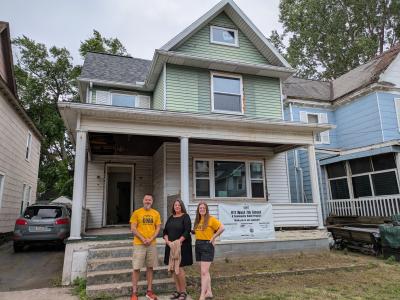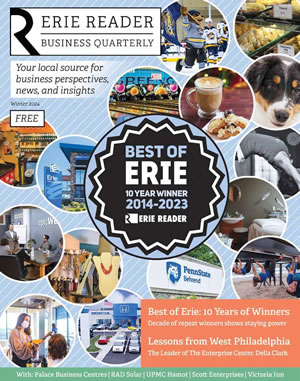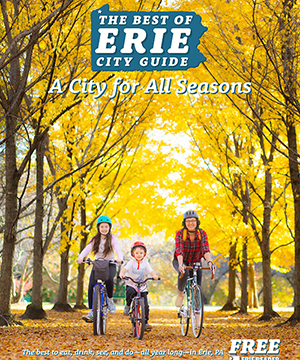Our West Bayfront is (Literally) Building Up Community
Volunteer-led renovation saves blighted building, aids in affordable home ownership
Back in 2020 when I first started writing for the Reader, I had the opportunity to include my nonprofit pick in the annual Erie Reader Gives feature (you can read this year's version within this issue). That year I chose to donate to our local neighborhood support organization Our West Bayfront (OWB) stating, and I'll quote myself here, "Our West Bayfront has helped me achieve a major parenting goal, which is to instill a sense of community in my children: your neighbors are like your family and helping them helps everyone have a better quality of life."
My husband and I moved into this neighborhood back in 2004 and eventually purchased our home here in 2009 (the West Bayfront neighborhood stretches from Sassafras to Weschler, and from the Bayfront south to West 12th Street) and since that time, we have witnessed so many positive changes – changes that have actively increased that sense of community including outreach, area clean-ups, public events allowing us to gather as a neighbors, and so many opportunities to help.
One such opportunity became available in 2023 when OWB was tipped off by the Erie Land Bank about a property within their footprint, 811 W. Seventh St., that was considered blighted – it had been sitting, empty and abandoned, for over 10 years. OWB, at that time helmed by Executive Director Anna Frantz, was able to purchase the property from the Land Bank with the intention to renovate the home. Inspired by his work with Habitat for Humanity, OWB board member Seph Kumer suggested that the organization utilize the willingness of so many neighbors and organizations to volunteer to help renovate and restore the home. Frantz comments, "We knew people wanted a different way to contribute directly … a way for people to really work in a tangible way to improve the neighborhood. We also had the right team in place at OWB – with staff like Dan Pertl who could manage the construction side and Marissa Litzenberg who could organize and motivate lots of volunteers – and with the opportunity for grant funding from the Emerging Erie Fund, it all came together."
In November of 2023, the first work began on the home that is often simply referred to as 811. The women's basketball team from Gannon University spent that first weekend hauling out trash, debris, and furniture that was left abandoned in the home to clear things out and get a better sense of what they were dealing with. And it wasn't pretty.
Luckily, along with an army of neighborhood volunteers, a few skilled lead volunteers stepped up to direct the work, many of whom are retired contractors including Bren Lindell, Doug Boucher, Tom Alderton, and Brett McCorkle. These folks have dedicated multiple days a week for years to the renovation, and have provided valuable skills and knowledge to see this project through to completion. McCorkle reflected on the condition of the home when they first took on the project, "Saying the home was in rough shape doesn't do it justice. It was derelict. It was full of garbage. It was water-damaged. There was mold in the basement covering everything."
But it wasn't always this way. For most of this building's history, it was a well-loved family home. Constructed around 1907, one of the earliest occupants was the Aldrich family. J.D. Aldrich was a decorator, painter, and hardwood refinisher by trade. Later in the home's history, it came into the Quirk family, who occupied the home throughout most of its history. John Quirk was the general manager of the Erie Wallpaper and Paint company. His wife Carrie was a local musician and was the organist at St. Patrick's Church. The couple had five children who grew up in this house. After John and Carrie passed away, their son William lived in the home with his wife Patricia. William was a physics and chemistry teacher at Academy High School and Patricia was a nurse at St. Vincent Hospital. At some point after the Quirks, the home was occupied by someone who eventually abandoned it. All this is to say, what was left in disrepair and destruction was once a home with a rich history full of love and family – and that history deserves to be honored. A vacant lot doesn't contribute to the story of a neighborhood and no one at OWB wanted to see that happen to this home.
Since the beginning of the project in 2023, there has been a total staff overhaul at OWB. Gretchen Kerr, who is a neighbor and a long-time volunteer with OWB, has taken over the executive director role while Starla Cochenour is now the neighborhood outreach manager and Joel Travis is the property asset manager. I met with all three of them as work on the home nears the finish line, but it wasn't my first time in the home.
On March 16, 2024, I volunteered, along with a group of Gannon students, some friends and neighbors, and the staff of OWB to help out at the home. Many were tasked with clearing out some rotting fencing in the backyard, some were working on stripping out a back addition that had suffered significant water damage, and I was in a room with a few others removing wallpaper to (hopefully) salvage the plaster and save on drywall costs. It was incredibly inspiring to see so many people dedicating their Saturday to help keep a local home from ending up in the landfill, to continue contributing its character to our neighborhood, and to eventually become a safe, affordable home for a local family. That is really the end goal of this whole project: to honor the home and the neighborhood, while also providing a stable place for a family to build a life.
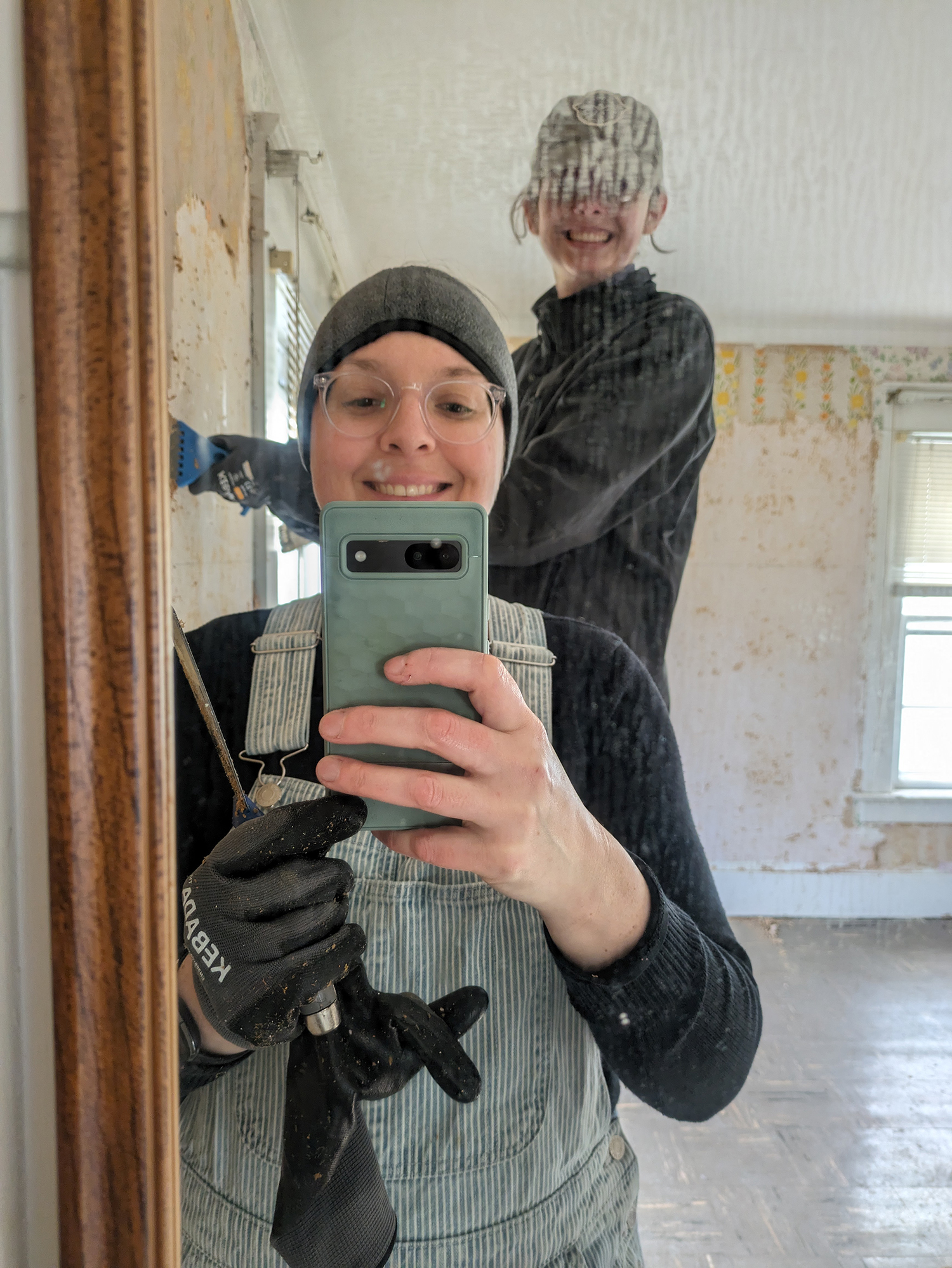 Myself and Marissa Litzenberg (former project manager for Our West Bayfront) stripping wallpaper at 811 W. Seventh Street along with a slew of volunteers spread throughout the property, in March of 2024. (Photo: Erin Phillips)
Myself and Marissa Litzenberg (former project manager for Our West Bayfront) stripping wallpaper at 811 W. Seventh Street along with a slew of volunteers spread throughout the property, in March of 2024. (Photo: Erin Phillips)
Enter the Cornerstone Community Land Trust (CCLT). Since OWB was able to obtain the property at 811 W. Seventh St. from the Land Bank for a very low price, and because the work being done on the house is coming largely from volunteer labor (keeping in mind, those things that require licenses to complete like electrical work, plumbing, and HVAC, along with some of the more detailed skillful jobs have been contracted out using grant or sponsorship funding), OWB now has the opportunity to donate this home to the CCLT.
The director of the CCLT, Kyra Taylor (Erie's 40 Under 40 Class of 2020), who is also the co-founder and executive director of Erie's Black Wall Street, explains the program: "The Cornerstone Community Land Trust was created to address the need for permanently affordable homeownership in Erie. As a land trust, we acquire and retain ownership of the land, while allowing individuals and families to purchase the homes built on that land. This structure ensures long-term affordability while allowing residents to build equity and remain rooted in their neighborhoods."
Cochenour concurs, "With renovations can come displacement of folks, and as property values continue to rise, things get more sensitive. CCLT kind of helps nip that in the bud." And 811 will be the very first home brought into the budding CCLT program. Taylor notes, "It represents so much more than just one unit of housing. This home is a community-driven rehabilitation project powered by volunteer labor and neighborhood energy. Once complete, the home will be sold to an income-qualified buyer through the CCLT model, preserving affordability now and for future generations."
Additionally, the land trust prevents behaviors like flipping and price gouging, slum landlords or, really, rentals of any kind, and the CCLT has built-in protections so if the family is having trouble making their mortgage, the land trust is there as a parachute. And if or when the family who owns the home decides to sell it, they must sell the home at market rate, while the land remains with the trust. This helps prevent properties from falling into disrepair while assisting families in building up generational stability and wealth, and at the same time stabilizing the neighborhood. It feels like a revolutionary concept, but this type of program exists and is successful in a number of places throughout the country. Erie is just getting started.
"CCLT operates in collaboration with a growing network of mission-aligned partners, including Our West Bayfront, Erie's Black Wall Street, Sisters of St. Joseph Neighborhood Network, St. Martin Center, GECAC, and others," Taylor shares. "These organizations play a vital role in community outreach, homeowner education, and identifying qualified buyers. The land trust model is rooted in partnership and stewardship, and these local groups are essential to that ecosystem."
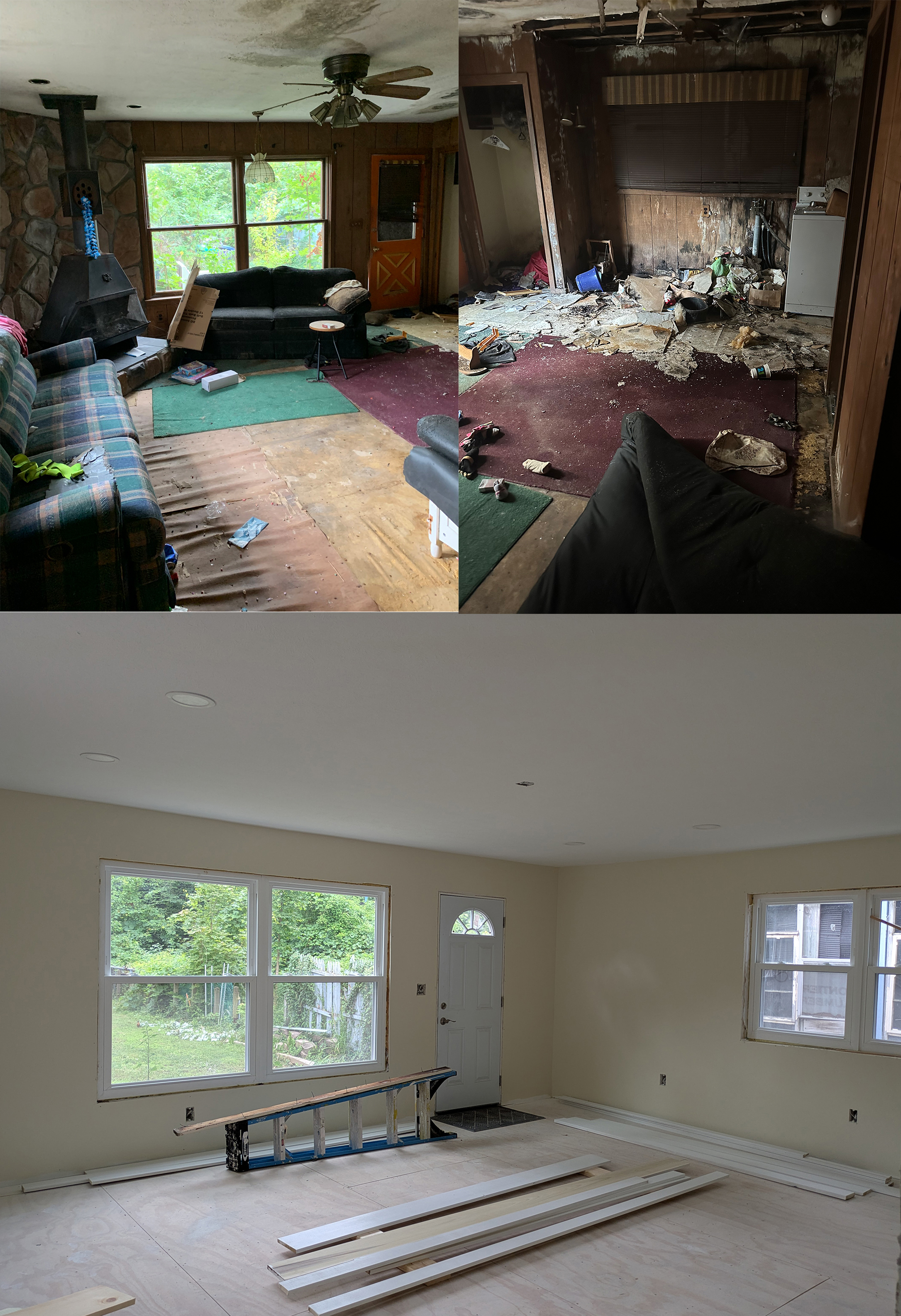
These photos show a before and after of an addition on the back of the home at 811 W. Seventh Street that was water damaged, rotting, and in major disrepair when Our West Bayfront took ownership of the home from the Land Bank in 2023. Today, the area has been totally repaired and made safe and beautiful through the work of neighborhood volunteers. (Photos: Contributed/Erin Phillips)
When it comes to that kind of cross-organizational cooperative ecosystem, the 811 project stands as a perfect example. OWB's property asset manager Joel Travis started his career in contracting doing residential remodels, but he felt the call to help on a larger scale. Since, he has worked as an instructor in the construction trades training program at Erie Center for Arts and Technology (ECAT). Starla Cochenour was actually a student of his – having gone through ECAT's construction trades program herself, to better understand the scope of work and increase her effectiveness on projects like 811. Travis shares, "ECAT was when I first stepped into the nonprofit world, volunteering, being present, and seeing what needs were in the city. And I fell in love with it through that program." And now he's on staff at OWB, using his skills in both instruction (which is a huge part of managing a team of volunteers) and construction.
Additionally, construction students from ECAT get to put their newly learned skills into practice at 811. Kerr comments on the collaboration, "We're having on-the-job training with the trade students with ECAT, not only on this house, but also on people's properties with residents who need help – so they get the experience of working with a client." She continues, "It's a symbiotic relationship with a lot of nonprofits. Groundwork Erie is maintaining all of our lots. They're doing all of our mowing – so instead of paying a local landscaper, we're paying Groundwork Erie for that work. So it's all coalescing into a large shared ecosystem of training for youth, summer employment, and property management needs. And I can see it growing."
Cochenour concurs, "This project isn't happening in a vacuum. It requires so much collaboration with other nonprofits, volunteers, and neighbors. It's our project but it's also everybody else's, so it's nice to see everyone corralling around it. I'm going to be sad when it's over, even though I'll be so excited to see a family here."
While the project is not yet complete, it is definitely getting close. Recently volunteer employee groups from National Fuel have come in to completely paint the first floor in one go. McCorkle shares, "I've lost count of the number of volunteers who came through. I organized three or four different groups of employees from Erie Insurance to come through and help, nearing almost 200 hours of volunteer time." The upper floors are still a ways from completion, but once they're over the final hurdle, OWB plans to hold an open house celebration to thank the community for all of their hours of help.
Kerr speaks on the scope of the whole project, "Working on this house has been one of my favorite things to do since I started this job. It truly is working with people in your neighborhood on a large scale project where you see immediate results and I've loved it."
As I reflect on that statement I made about Our West Bayfront way back in 2020, I can say with certainty that the organization has helped to instill a sense of community in my children. We know everyone on our block, we say hello as we pass, we help each other shovel out our elderly neighbors, we join each other for community events (like last Tuesday's National Night Out in Gridley Park or Porchfest coming up in September), and we volunteer together. We all know, deep down, that we have each other's backs. Projects like 811 bring our neighborhood even closer – and I can say with certainty that whatever lucky family gets to eventually live in 811, which has been touched by so much generosity and love, that they will be welcomed into Our West Bayfront with warm, open arms.
While the lion's share of the work that has happened at 811 has come from volunteers, the project's material costs were covered through generous community sponsorships and funding from the Emerging Erie Fund and Great Lakes Insurance.
Our West Bayfront is participating in Erie Gives Day on Tuesday, Aug. 12. Additionally, other nonprofits mentioned in this article are participating including ECAT, Groundwork Erie, Sisters of St. Joseph, Erie's Black Wall Street, St. Martin Center, and GECAC. Visit eriegives.org to donate.
If you're interested in volunteering with Our West Bayfront, either at 811 or in any other capacity, visit ourwestbayfront.org
Erin Phillips, when not standing in awe at the bay view, the historic homes, or the lovely people in her West Bayfront neighborhood, can be reached at erin@eriereader.com
